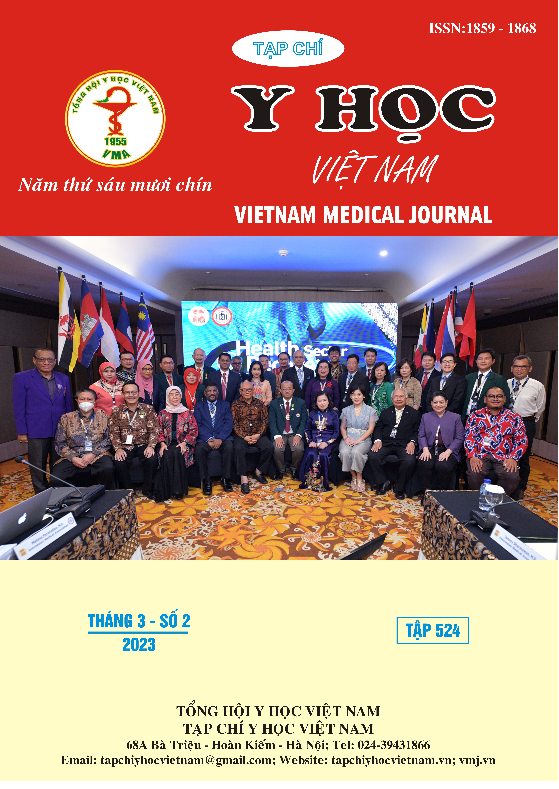A NUMBER OF FACTORS ASSOCIATED WITH NUTRITIONAL CONDITION AFTER SURGERY IN STOMACH CANCER PATIENTS AT NGHE AN ONCOLOGY HOSPITAL IN 2022
Main Article Content
Abstract
Background: Stomach cancer (SC) is one of the common cancers all over the word. According to Globocan 2020, SC incidence ranked fiftth (5,6% equal to 1.089.103 cases). Gastrointestinal cancer has been proved to have a higher malnutrition rate (20% – 85%) compared to other types of cancer, in which 19% - 94% of stomach cancer patients were diagnosed with malnutrition. Malnutrition before and after operation can impact decisions on treatment and patients immune system, increase the rate of post-operative complications such as surgical wound infection (5% - 52%), reduce response, increase the treatment costs (to more than 25%), prolong the hospitalization (8 - 60 days), raise the death rate. All of those effects would thus deteriorate patients quality of life, response and prognosis. Objective: Identify the malnutrition rate and analysis of some factors related to nutritional after after surgery in stomach cancer patients at Nghe An Oncology Hospital in 2022. Materials and Methods: Descriptive cross-sectional study with analysis was conducted on 120 stomach cancer patients at Nghe An Oncology Hospital from January 2022 to May 2022. The information was collected by a set of questionnaire which were used during direct interviews, carrying out medical examination and analyzing medical records. Results: The malnutrition rate after operation by PG-SGA was 53.3%, in which the rate of severe malnutrition accounted for 21.6% and the conditions measured according to BMI and Albumin were 52.2% and 38.3% respectively. There was a relationship between the nutritional status of patients after surgery with indications for surgery, postoperative fever, weight loss within 1 month and reduction of subcutaneous fat, muscle atrophy, edema (p < 0.05). Conclusions: The general assessment for SC cancer after operation must be conducted to timely and rationally solve any problems and increase the effectiveness in treatment.
Article Details
Keywords
malnutrition, stomach cancer, PG-SGA, surgery.
References
2. N. V. Pham và các cộng sự. (2007), "SGA and measures for muscle mass and strength in surgical Vietnamese patients", Nutrition. 23(4), tr. 283-91.
3. Lương Đức Dũng (2013), Thực trạng dinh dưỡng của bệnh nhân phẫu thuật ổ bụng đường tiêu hóa tại khoa ngoại bệnh viện Bạch Mai 6 tháng đầu năm 2013, Trường Đại học Y Hà Nội., chủ biên.
4. Trịnh Hồng Sơn (2013), "Đánh giá tình trạng dinh dưỡng của người bệnh trước mổ ung thư dạ dày tại khoa C1, bệnh viện Việt Đức Hà Nội năm 2013".
5. Nguyễn Thị Thúy và CS (2020-2021), "Tình trạng dinh dưỡng của người bệnh ung thư dạ dày trong quá trình điều trị hóa chất tại Bệnh viện K".
6. Nguyễn Thị Ngọc Lan (2021), "Tình trạng dinh dưỡng và đặc điểm kiểu gen của người bệnh ung thư dạ dày tại 4 bệnh viện ở Hà Nội. Tạp Chí Nghiên cứu Y học", tr. 147(11), 63-71.
7. Y. Fukuda và các cộng sự. (2015), "Prevalence of Malnutrition Among Gastric Cancer Patients Undergoing Gastrectomy and Optimal Preoperative Nutritional Support for Preventing Surgical Site Infections", Ann Surg Oncol. 22 Suppl 3, tr. S778-85.
8. I. Deftereos và các cộng sự. (2020), "A systematic review of the effect of preoperative nutrition support on nutritional status and treatment outcomes in upper gastrointestinal cancer resection", Eur J Surg Oncol. 46(8), tr. 1423-1434.
9. Nguyễn Tuấn Anh (2014), "Hiệu quả nuôi ăn sớm sau phẫu thuật cắt đoạn dạ dày nội soi điều trị ung thư dạ dày tại Bệnh viện Quân Y 103.".
10. F. D Ottery, McCallum, P. D, và Polisena, C.G (2000), "Patient generated subjective global assessment", 11-23.


